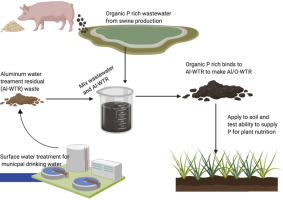当前位置:
X-MOL 学术
›
Chemosphere
›
论文详情
Our official English website, www.x-mol.net, welcomes your
feedback! (Note: you will need to create a separate account there.)
Assessing modified aluminum-based water treatment residuals as a plant-available phosphorus source.
Chemosphere ( IF 8.1 ) Pub Date : 2020-01-17 , DOI: 10.1016/j.chemosphere.2020.125949 Travis Banet 1 , Michael S Massey 2 , Iris Zohar 3 , M Iggy Litaor 3 , James A Ippolito 1
Chemosphere ( IF 8.1 ) Pub Date : 2020-01-17 , DOI: 10.1016/j.chemosphere.2020.125949 Travis Banet 1 , Michael S Massey 2 , Iris Zohar 3 , M Iggy Litaor 3 , James A Ippolito 1
Affiliation

|
Inorganic phosphorus (P) fertilizers are a finite resource; alternative means of creating P fertilizers from current municipal and agricultural waste sources may reduce our reliance on phosphate rock mining, and improve waste disposal and nutrient cycling. Previous research demonstrated that organic aluminum water treatment residual composites (Al/O-WTR), created by mixing aluminum water treatment residuals (Al-WTR) with swine wastewater, have the potential to be a source of plant-available P. A greenhouse study was conducted to compare spring wheat (Triticum aestivum L.) growth with increasing application rates of swine wastewater-derived Al/O-WTR and commercial P fertilizer (both applied at 34, 67, and 135 kg P2O5 ha-1) in either sandy loam or sandy clay loam soil. Spring wheat straw and grain P uptake were comparable across all treatments in the sandy loam, while straw and grain P uptake were lower with Al/O-WTR in the sandy clay loam. The Al/O-WTR did not affect soil organic P concentrations, but did increase phosphatase activity in both soils. Increased phosphatase activity suggests that Al/O-WTR application stimulated microorganisms and enhanced the extent to which microbial communities mineralized Al/O-WTR-bound organic P. Overall, these results suggest that Al-WTR can be used to make P fertilizer, combining two "waste" products to create a useful product. Phosphorus harvesting via Al/O-WTR may be a feasible future alternative to mining phosphate rock, while avoiding unnecessary waste disposal and improving agricultural nutrient cycling.
中文翻译:

评估改性铝基水处理残留物作为植物可用的磷源。
无机磷肥是一种有限的资源。从当前的市政和农业废物源生产磷肥的替代方法可能会减少我们对磷矿石开采的依赖,并改善废物处置和养分循环。先前的研究表明,通过将铝水处理残留物(Al-WTR)与猪废水混合而制成的有机铝水处理残留复合物(Al / O-WTR)有可能成为植物体内可利用的磷的来源。温室研究进行了比较,在两种沙质土壤中,春小麦(Triticum aestivum L.)的生长与猪源废水中的Al / O-WTR和商品P肥料(分别以34、67和135 kg P2O5 ha-1施用)的增加施用量进行了比较壤土或沙质壤土。在所有处理中,沙壤土中的春小麦秸秆和籽粒P吸收量均相当,而Al / O-WTR在沙壤土中的秸秆和籽粒P吸收量较低。Al / O-WTR不会影响土壤有机磷的浓度,但会增加两种土壤中的磷酸酶活性。磷酸酶活性的提高表明,Al / O-WTR的施用刺激了微生物,并增强了微生物群落使结合了Al / O-WTR的有机磷矿化的程度。总体而言,这些结果表明,Al-WTR可用于制造磷肥,结合使用两种“废物”产品创造出有用的产品。通过Al / O-WTR收获磷可能是替代开采磷矿石的可行的未来选择,同时避免不必要的废物处理并改善农业养分循环。Al / O-WTR在砂质壤土中的秸秆和谷物中P的吸收较低。Al / O-WTR不会影响土壤有机磷的浓度,但会增加两种土壤中的磷酸酶活性。磷酸酶活性的提高表明,Al / O-WTR的施用刺激了微生物,并增强了微生物群落使结合了Al / O-WTR的有机磷矿化的程度。总体而言,这些结果表明,Al-WTR可用于制造磷肥,结合使用两种“废物”产品创造出有用的产品。通过Al / O-WTR收获磷可能是替代开采磷矿石的可行的未来选择,同时避免不必要的废物处理并改善农业养分循环。Al / O-WTR在砂质壤土中的秸秆和谷物中P的吸收较低。Al / O-WTR不会影响土壤有机磷的浓度,但会增加两种土壤中的磷酸酶活性。磷酸酶活性的提高表明,Al / O-WTR的施用刺激了微生物,并增强了微生物群落使结合了Al / O-WTR的有机磷矿化的程度。总体而言,这些结果表明,Al-WTR可用于制造磷肥,结合使用两种“废物”产品创造出有用的产品。通过Al / O-WTR收获磷可能是替代开采磷矿石的可行的未来选择,同时避免不必要的废物处理并改善农业养分循环。磷酸酶活性的提高表明Al / O-WTR的施用刺激了微生物,并增强了微生物群落使Al / O-WTR结合的有机P矿化的程度。总体而言,这些结果表明Al-WTR可用于制造P肥料,结合使用两种“废物”产品创造出有用的产品。通过Al / O-WTR进行磷采收可能是替代磷矿石开采的可行的未来选择,同时避免不必要的废物处理并改善农业养分循环。磷酸酶活性的提高表明,Al / O-WTR的施用刺激了微生物,并增强了微生物群落使结合了Al / O-WTR的有机磷矿化的程度。总体而言,这些结果表明,Al-WTR可用于制造磷肥,结合使用两种“废物”产品创造出有用的产品。通过Al / O-WTR收获磷可能是替代开采磷矿石的可行的未来选择,同时避免不必要的废物处理并改善农业养分循环。
更新日期:2020-01-17
中文翻译:

评估改性铝基水处理残留物作为植物可用的磷源。
无机磷肥是一种有限的资源。从当前的市政和农业废物源生产磷肥的替代方法可能会减少我们对磷矿石开采的依赖,并改善废物处置和养分循环。先前的研究表明,通过将铝水处理残留物(Al-WTR)与猪废水混合而制成的有机铝水处理残留复合物(Al / O-WTR)有可能成为植物体内可利用的磷的来源。温室研究进行了比较,在两种沙质土壤中,春小麦(Triticum aestivum L.)的生长与猪源废水中的Al / O-WTR和商品P肥料(分别以34、67和135 kg P2O5 ha-1施用)的增加施用量进行了比较壤土或沙质壤土。在所有处理中,沙壤土中的春小麦秸秆和籽粒P吸收量均相当,而Al / O-WTR在沙壤土中的秸秆和籽粒P吸收量较低。Al / O-WTR不会影响土壤有机磷的浓度,但会增加两种土壤中的磷酸酶活性。磷酸酶活性的提高表明,Al / O-WTR的施用刺激了微生物,并增强了微生物群落使结合了Al / O-WTR的有机磷矿化的程度。总体而言,这些结果表明,Al-WTR可用于制造磷肥,结合使用两种“废物”产品创造出有用的产品。通过Al / O-WTR收获磷可能是替代开采磷矿石的可行的未来选择,同时避免不必要的废物处理并改善农业养分循环。Al / O-WTR在砂质壤土中的秸秆和谷物中P的吸收较低。Al / O-WTR不会影响土壤有机磷的浓度,但会增加两种土壤中的磷酸酶活性。磷酸酶活性的提高表明,Al / O-WTR的施用刺激了微生物,并增强了微生物群落使结合了Al / O-WTR的有机磷矿化的程度。总体而言,这些结果表明,Al-WTR可用于制造磷肥,结合使用两种“废物”产品创造出有用的产品。通过Al / O-WTR收获磷可能是替代开采磷矿石的可行的未来选择,同时避免不必要的废物处理并改善农业养分循环。Al / O-WTR在砂质壤土中的秸秆和谷物中P的吸收较低。Al / O-WTR不会影响土壤有机磷的浓度,但会增加两种土壤中的磷酸酶活性。磷酸酶活性的提高表明,Al / O-WTR的施用刺激了微生物,并增强了微生物群落使结合了Al / O-WTR的有机磷矿化的程度。总体而言,这些结果表明,Al-WTR可用于制造磷肥,结合使用两种“废物”产品创造出有用的产品。通过Al / O-WTR收获磷可能是替代开采磷矿石的可行的未来选择,同时避免不必要的废物处理并改善农业养分循环。磷酸酶活性的提高表明Al / O-WTR的施用刺激了微生物,并增强了微生物群落使Al / O-WTR结合的有机P矿化的程度。总体而言,这些结果表明Al-WTR可用于制造P肥料,结合使用两种“废物”产品创造出有用的产品。通过Al / O-WTR进行磷采收可能是替代磷矿石开采的可行的未来选择,同时避免不必要的废物处理并改善农业养分循环。磷酸酶活性的提高表明,Al / O-WTR的施用刺激了微生物,并增强了微生物群落使结合了Al / O-WTR的有机磷矿化的程度。总体而言,这些结果表明,Al-WTR可用于制造磷肥,结合使用两种“废物”产品创造出有用的产品。通过Al / O-WTR收获磷可能是替代开采磷矿石的可行的未来选择,同时避免不必要的废物处理并改善农业养分循环。









































 京公网安备 11010802027423号
京公网安备 11010802027423号